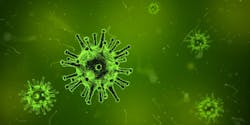Roger Nathanson is president of Ozone Pure Water, Inc., Kerrville, Texas, and Sarasota, Fla. He can be reached at 800.633.8469, or by e-mail at [email protected].
Updated 3/30/21
All water contains microbes—living organisms that feed on organics, metals, petroleum, chemicals and each other. While most microbes are completely harmless and pose no health risks, others can be dangerous.
What are the most commonly occurring harmful microbes? E. coli is the benchmark as far as harmful microbes are concerned. If a water supply is from a sealed, drilled well greater than 80 ft deep, the chance of naturally occurring E. coli is low. Similarly, viruses, protozoa, fungi and cysts rarely occur. It is very common, however, to find nuisance microbes that form biofilm and/or create offensive tastes and odors.
If a water supply comes from a lake, creek, pond, stream, cistern, rain catchment/roof runoff or other surface source, then the water could have an extreme amount of dangerous microbes. It is very important to kill all the bacteria due to the chance of propagation from even a single bacterium. In addition, there are many ailments that are associated with parasitic contamination, and some can be quite debilitating. Children, infants, the elderly and people with immune deficiencies are at even greater risks.
RELATED: Ozone: A Natural Phenomenon
How Does Ozone Disinfection Kill Bacteria?
This article will focus on the use of ozone as a water treatment method that can cure water woes such as iron, sulfur, manganese, bad taste and odor, and of course, bacteria/microbes.
There are many benefits realized from using ozone. One benefit is the variety of microbes ozone can kill with a small dose and residual. Many factors determine the residual, but generally, the higher the ozone production, the higher the residual and the longer it will last in the water. The required residual is dictated by the amount and type of microbes to be killed. When ozone degrades, it reverts back to oxygen; thus, it is safe, and not a chemical hazard to people, equipment or the environment.
Dosage = The amount of ozone that is produced by a given ozonator and injected into the water
Residual = The amount of ozone remaining after everything has been oxidized
Ozone oxidizes the organic material in bacterial membranes, which weakens the cell wall and leads to cellular rupture. This exposes the organism to the external environment, which causes almost immediate death of the cell.
Ozone can effectively kill bacteria as well as Giardia, Cryptosporidium, parasites, fungi, molds and other microbes. The ozonation standard for killing most organisms is to maintain 0.3 ppm for a three-minute contact time. The dosage and contact time can vary.
System Size & Design
An ozonator is sized according to the amount of bacteria, the level of kill required and the gpm flow rate. There is no maximum contaminant level, but higher contamination levels will require more ozone. The initial cost of an ozone system can be high. In the long run, however, ozone might be the more cost-effective choice due to the minimal maintenance associated with some ozone systems.
You must be able to answer the following questions to size an ozone system:
- What is the maximum flow rate in gallons per minute?
- What bacteria and/or other microbes are to be eliminated?
- Is there anything in the water that ozone can oxidize, such as iron, sulfur or manganese?
Most ozone systems consist of the same general components. These include the ozonator, off gas tank, filtration and actuation device.
Ozonator. The ozonator size (grams per hour) will be based on the answers to the previous questions. It will consist of the ozone-generating unit and ozone injection device.
Off gas tank. Pressure is what keeps the ozone in the solution, thus extending the contact time. An off gas tank allows the ozone to be in contact with the water for an extended time prior to being used. The off gas tank has a gas release to eliminate excessive gas/ozone buildup.
Filtration. Automatic or cartridge-type filtration is used, depending on the contaminant level and type. Filtration is not necessary for the removal of microbes; it is used to eliminate iron, sulfur, manganese and color.
Actuation device. A device needs to activate the ozonator. This can be a flow switch or pressure switch, depending on the application.
As you can see, the sizing and installation of an ozone system are simple. Maintenance is also simple, depending on the product selected.
Follow-Up Service
When it comes to follow-up service, you should ask yourself: Are profits worth the liability of being responsible for the end user’s health? Or in other words, how can you guarantee continued potability if the equipment is not maintained and regular testing is not performed? Unless the parameters and guidelines for maintaining potability are clearly outlined, you could be held responsible for selling water treatment equipment to create potability where there was none prior.
To avoid any legal issues, you must establish a regular follow-up procedure. You must also ask the customer to agree in writing that a certified lab will test the water regularly; otherwise the water will no longer be rated as potable.
In order to protect yourself and the consumer, it is important to understand how ozone works in various applications. Ozone systems work well when sized and applied properly; however, limits must be understood, and follow-up service guidelines must be established to ensure effective and positive results.



